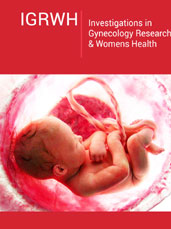- Submissions

Abstract
Investigations in Gynecology Research & Womens Health
Pregnancy Outcomes after Antepartum Diagnosis of Oligohydramnios at or Beyond 34 Weeks
-
Open or CloseInshal Jawed1*, Fasiha Bakhtawar Fatima1, Mohammad Omer Alam2, Hina Khan3, Basma wahab Memon4, Komal Devi5, Rahul Rai6, Muhammad Umair7, Farah Alam8, Shaheer Afsah Jawed8 and Sumbul Mukhtar9
1Department of Internal Medicine, Dow University of Health Sciences, Pakistan
2Department Internal Medicine, Jinnah Sindh Medical University, Pakistan
3Department of general surgery, Jinnah postgraduate medical centre, Pakistan
4People’s University of Medical Science and Health Nawabshah, Pakistan
5United Medical and Dental College, Pakistan
6Liaquat University of Medical and Health Sciences, Pakistan
7Dow University of Health Sciences, Pakistan
8Baqai Medical University, Pakistan
9Oral Biology Department, Bahria University of Health Sciences (BUHSC), Pakistan
*Corresponding author:Inshal Jawed, Department of Internal Medicine, Dow University of Health Sciences, Pakistan
Submission:January 23, 2025;Published: February 10, 2025
Abstract
Background: Amniotic fluid serves as a vital component in supporting fetal development during pregnancy. Oligohydramnios, a condition characterized by low amniotic fluid levels, presents concerns for obstetric care due to its potential implications on maternal and fetal health.
Methods: A retrospective cross-sectional study was conducted at Tertiary Care Hospital, analyzing the records of 50 pregnant women diagnosed with oligohydramnios at or after 34 weeks of gestation. Various demographic characteristics, maternal risk factors, mode of delivery, and neonatal outcomes were assessed.
Result: The analysis revealed several significant associations between oligohydramnios and adverse pregnancy outcomes. Women diagnosed with oligohydramnios exhibited higher gravidity and parity, along with increased risks of preterm birth, low birth weight in infants, and neonatal complications. The mode of delivery was significantly correlated with gestational age at delivery, impacting the incidence of emergency cesarean sections.
Conclusion: This study sheds light on the associations between oligohydramnios and adverse pregnancy outcomes, urging clinicians to consider close monitoring and tailored management strategies for pregnancies diagnosed with this condition.
Keywords:Oligohydramnios; New born complications; Maternal outcomes; Fetal death; Amniotic fluid
 a Creative Commons Attribution 4.0 International License. Based on a work at www.crimsonpublishers.com.
Best viewed in
a Creative Commons Attribution 4.0 International License. Based on a work at www.crimsonpublishers.com.
Best viewed in 








.jpg)






























 Editorial Board Registrations
Editorial Board Registrations Submit your Article
Submit your Article Refer a Friend
Refer a Friend Advertise With Us
Advertise With Us
.jpg)






.jpg)














.bmp)
.jpg)
.png)
.jpg)










.jpg)






.png)

.png)



.png)






